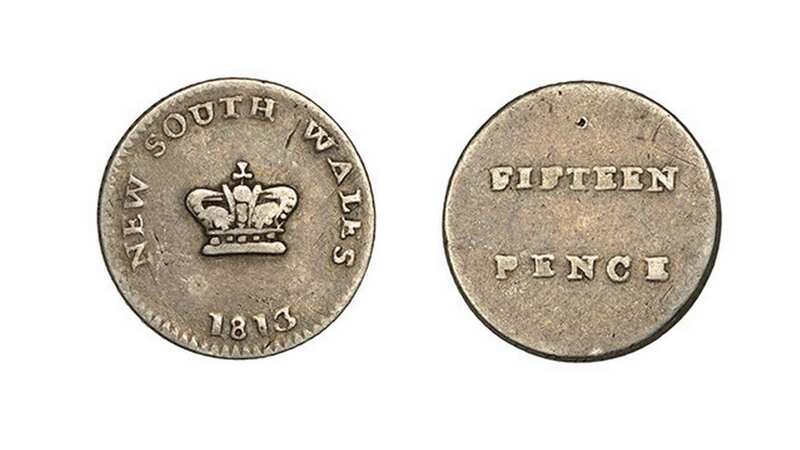Rare Australian 15p coin to fetch thousands after being found in Oxfam donation

An ultra rare Aussie coin found in a London charity shop is expected to sell for thousands of pounds at auction next week.
The 15p coin, known as a 'Dump', dates back to the early 19th century and was found in a bag of coins donated to an Oxfam store in Orpington, south east London. Oxfam volunteer and former banker, John Turner, who first spotted the coin, identified it as a rarity.
Mr Turner took the coin to Noonans Mayfair auction house in central London for a second opinion, where experts confirmed that it was an Australian New South Wales 15p piece from 1813 - and is older than the country of Australia.
The coin is now estimated to fetch up to £7,000 when it goes under the hammer as part of a two-day sale of Coins and Historical Medals on Tuesday February 6 and Wednesday February 7.
Mr Turner, who lives in Bromley and is based at his local Bromley shop in south east London, regularly visits other Oxfam stores in the area. He said: “I started collecting British coins when I was a teenager and more latterly also British Empire money, so I had some knowledge to build on; but I have learned a lot from volunteering. In April last year I was invited to sort some donations of loose material in bags at the Orpington shop.
 Teen 'kept as slave, starved and beaten' sues adoptive parents and authorities
Teen 'kept as slave, starved and beaten' sues adoptive parents and authorities
 Former banker, John Turner, who found the coin, knew it was a rarity (Noonans / SWNS)
Former banker, John Turner, who found the coin, knew it was a rarity (Noonans / SWNS)"On a cursory examination, these appeared to be largely what I would describe as ‘holiday money’- with some, but little or no collectable value. Having sorted the ‘easy’ items into various categories, and priced a few items requiring some look up, I was left with a small silver-grey coloured item I had never seen before, inscribed 'New South Wales 1813 Fifteen Pence'.
"Using the internet as my first line of enquiry, I found two such items that had sold for between £30 and £50, described as ‘most likely Becker copies’. Not a value to be ignored, but a copy of what?”
After considerable online investigation, Mr Turner revealed the story of how the Governor of the New South Wales Penal Colony commissioned a reformed forger, who had been transported from England, to make coins for local circulation from 40,000 Spanish silver ‘pieces of eight’.
He punched out the centres -to form the dump - with the outside coin forming ‘holey’ dollars, and counter-stamped them with 'NSW' inscriptions. These were Australia’s first coins, before Australia was officially formed as a country.
Opinion seemed to be that only around 1,000 of each coin still existed, the majority having been melted down in the 1840s.
Mr Turner said: “Searches of auction site results, mainly in Australia but some UK, showed a wide variety of realised, prices, but one UK site showed a sale of over £2,000 for a ‘rough’ example, meaning one in significantly poorer condition than ours. Australian results were considerably higher. My guess was that if the coin was genuine it might be worth at least £5,000.
"However, this was well beyond my competence to judge, and given how it turned up, made it somehow unlikely. The bags from Orpington had not been marked as eligible for Gift Aid, meaning that there was no way of tracing the donor.
“After this research, I told the Orpington deputy manager that we should tell the Area Manager potentially what we might have. This eventually led to Oxfam referring the coin to Noonans, who were able to confirm the coin as genuine.”
He added: “It is brilliant to know the money raised from the coin will go towards Oxfam’s much-needed work to tackle poverty around the world.”
Shelley Hitch, Valuer at Oxfam, said: “The Orpington area manager passed the coin to me as she knew I had a relationship with several auction houses and Noonans kindly don’t charge Oxfam any commission. Volunteers like John are so valuable to Oxfam, and this is a great discovery. It means even more to know that the money raised will go towards vital funds to help tackle poverty across the globe.”
 Death fears for Emmerdale's Sarah as teen rushed to A&E after exposing secret
Death fears for Emmerdale's Sarah as teen rushed to A&E after exposing secret
Tim Wilkes, head of coins at Noonans, added: “The market for these early Australian pieces is very strong and we hope that this piece will do well.”
Read more similar news:
Comments:
comments powered by Disqus
































